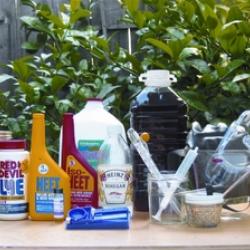Source Institutions
Source Institutions
Add to list Go to activity
Activity link broken? See if it's at the internet archive

In this activity, learners make a small batch of biodiesel that will work in any diesel engine. Learners use an old juice bottle as a "reactor" vessel to chemically process vegetable oil into fuel. Learners will discover that making biodiesel is much like cooking, since both are forgiving of improvisation and both require careful technique. This step by step instruction guide includes safety recommendations because the home-brewing process involves flammable, poisonous, and caustic chemicals, alcohols, and lye. Follow all directions carefully and ensure a responsible adult is present.
- Under 5 minutes
- 1 to 7 days
- $10 - $20 per group of students
- Ages 14 - adult
- Activity, Experiment/Lab Activity
- English
Quick Guide
Materials List (per group of students)
- 2 2-liter bottles
- candy thermometer
- electric burner or hotplate (no gas stoves or flames)
- funnel
- 3 or more glass jars (small Mason or baby-food sized)
- gloves, household cleaning
- marker
- 2 Mason jars, 1 pint, with lids
- measuring cup or beaker
- metric gram scale
- pot
- rags
- safety goggles
- spoon, plastic
- 2 syringes or eyedroppers or pipettes
- at least one liter vegetable oil (used or new)
- 1 bottle of methanol gasoline treatment
- cheesecloth
- 1 bottle of isopropyl alcohol gasoline treatment
- 5-10 grams lye
- litmus strips or electric pH meter (optional)
- phenolphthalein solution
- masking tape or labels
- 1-2 gallons distilled water
- vinegar
Subjects
-
Engineering and Technology
-
Engineering
- Bioengineering/Biomedical Engineering
- Chemical Engineering
- Transportation Engineering
-
Engineering
-
Mathematics
- Measurement
-
Physical Sciences
-
Heat and Thermodynamics
- Heat and Temperature
-
Chemistry
- Chemical Bonding
- Chemical Reactions
- Acids and Bases
- Solutions
-
Heat and Thermodynamics
-
The Nature of Technology
-
Technology and Society
- Technology and the Environment
-
Technology and Society
Informal Categories
- Outdoor Activity
- Transportation
Audience
To use this activity, learners need to:
- see
- see color
- read
- touch
Learning styles supported:
- Involves hands-on or lab activities
Other
This resource is part of:
Access Rights:
- Free access
By:
- Elam, Rob
Rights:
- All rights reserved, Make Projects, 2011
